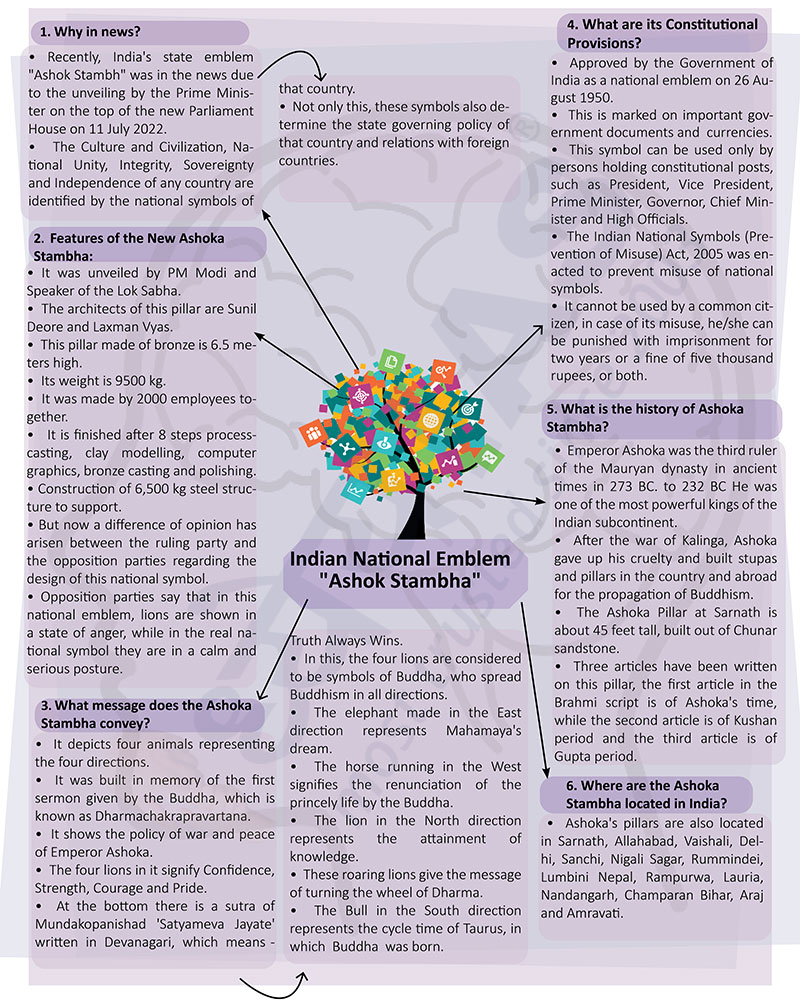Brain-booster /
16 Aug 2022
Brain Booster for UPSC & State PCS Examination (Topic: Indian National Emblem "Ashok Stambha")

Why in news?
- Recently, India's state emblem "Ashok Stambh" was in the news due to the
unveiling by the Prime Minister on the top of the new Parliament House on 11
July 2022.
- The Culture and Civilization, National Unity, Integrity, Sovereignty and
Independence of any country are identified by the national symbols of that
country.
- Not only this, these symbols also determine the state governing policy
of that country and relations with foreign countries.
Features of the New Ashoka Stambha:
- It was unveiled by PM Modi and Speaker of the Lok Sabha.
- The architects of this pillar are Sunil Deore and Laxman Vyas.
- This pillar made of bronze is 6.5 meters high.
- Its weight is 9500 kg.
- It was made by 2000 employees together.
- It is finished after 8 steps processcasting, clay modelling, computer
graphics, bronze casting and polishing.
- Construction of 6,500 kg steel structure to support.
- But now a difference of opinion has arisen between the ruling party and
the opposition parties regarding the design of this national symbol.
- Opposition parties say that in this national emblem, lions are shown in
a state of anger, while in the real national symbol they are in a calm and
serious posture.
What message does the Ashoka Stambha convey?
- It depicts four animals representing the four directions.
- It was built in memory of the first sermon given by the Buddha, which is
known as Dharmachakrapravartana.
- It shows the policy of war and peace of Emperor Ashoka.
- The four lions in it signify Confidence, Strength, Courage and Pride.
- At the bottom there is a sutra of Mundakopanishad 'Satyameva Jayate'
written in Devanagari, which means -Truth Always Wins.
- In this, the four lions are considered to be symbols of Buddha, who
spread Buddhism in all directions.
- The elephant made in the East direction represents Mahamaya's dream.
- The horse running in the West signifies the renunciation of the princely
life by the Buddha.
- The lion in the North direction represents the attainment of knowledge.
- These roaring lions give the message of turning the wheel of Dharma.
- The Bull in the South direction represents the cycle time of Taurus, in
which Buddha was born.
What are its Constitutional Provisions?
- Approved by the Government of India as a national emblem on 26 August
1950.
- This is marked on important government documents and currencies.
- This symbol can be used only by persons holding constitutional posts,
such as President, Vice President, Prime Minister, Governor, Chief Minister
and High Officials.
- The Indian National Symbols (Prevention of Misuse) Act, 2005 was enacted
to prevent misuse of national symbols.
- It cannot be used by a common citizen, in case of its misuse, he/she can
be punished with imprisonment for two years or a fine of five thousand
rupees, or both.
What is the history of Ashoka Stambha?
- Emperor Ashoka was the third ruler of the Mauryan dynasty in ancient
times in 273 BC. to 232 BC He was one of the most powerful kings of the
Indian subcontinent.
- After the war of Kalinga, Ashoka gave up his cruelty and built stupas
and pillars in the country and abroad for the propagation of Buddhism.
- The Ashoka Pillar at Sarnath is about 45 feet tall, built out of Chunar
sandstone.
- Three articles have been written on this pillar, the first article in
the Brahmi script is of Ashoka's time, while the second article is of Kushan
period and the third article is of Gupta period.
Where are the Ashoka Stambha located in India?
- Ashoka's pillars are also located in Sarnath, Allahabad, Vaishali,
Delhi, Sanchi, Nigali Sagar, Rummindei, Lumbini Nepal, Rampurwa, Lauria,
Nandangarh, Champaran Bihar, Araj and Amravati.








